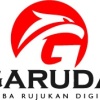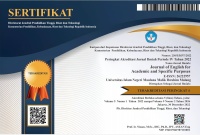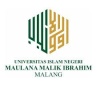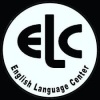DEVELOPING SUPPLEMENTARY READING MATERIALS FOR THE STUDENTS OF EIGHTH GRADERS NURUS SALAFIYAH PROBOLINGGO
Abstract
Full Text:
PDFReferences
Anonymous. (2012). Tips for selecting effective, authentic reading materials.http://elt-resourceful.com. Accessed on January 7 2013
Brown, H.D. (2007). Teaching by the principle: An Interactive Approach to Language Pedagogy. Third Edition. New York. Pearson Edition
Bamford. (1998). Extensive Reading in Tshe Second Language Classroom. Cambridge: Cambridge University Press
Cunningsworth, A. (1995). Coursebook. London: Macmillan Heinemann (English Language Teaching)
Diknas. Standar Isi dan Standar Kompetensi Lulusan Tingkat Sekolah Mengeah Pertama dan Madrasah Tsanawiyah Peraturan Mendiknas No. 22, No. 23 dan No. 24 th. 2006. 2006. Jakarta: PT Binatama Raya
William, G. & Stoller, F. L. (2002).Teaching and Researching Reading. London: Pearson Education Longman.
Guo.S. (2012). Using Authentic Materials for Extensive Reading to Promote English Proficiency. English Language Teaching; Vol.5, No.8 Canadian Center of Science and Education.
Harmer, J. (2007). The Practice of English Language Teaching. London. Longman
Yuen, K. (2011). THE Representation of Foreign Cultures in English Textbook. ELT Journal Volume 65/4, Oxford University Press.
Krashen.S. (2003) .Exploration in Language Acquisition and Use. Portsmouth Heinemann.
Kelly, C. (2002). Effective Ways to Use Authentic Matrials with ESL/EFL student. The internet TESOL journal, Vol.VIII, No 11, November 2002. Retrieved from http:/iteslj.org
Latief, A. (2009). Educational Research & Development. On line Publication. University of Pittsburg and Universitas Negeri Malang. Accessed on January 2014.
Lynch, L. (2012). Throw Away The Course Book and Adapt Authentic Material.retrieved at February 26, 2013 from http://www.eslbase.com/article/authentic-materials-2
Martinez, A.G. (2002). Authentic Materials: an Overview,Karens Linguistics Issues, retrieved February 26, 2013 from http://www3.telus.net/linguistics issues/authentic-materials.html
Nation, P. (2002). Managing Vocabulary Learning.RELC portfolio series. Orange grove read: SEAMAO Regional Language Center
Nunan, D. (1991). Designing Tasks for Communicative Classroom. Sydney: Cambridge University Press.
Ono, L and R, R day and K harsh. (2004). Tips for Reading Extensively. English Teaching Forum. October 2004.
Ribahan. (2008). Developing Reading Comprehension Materials for Students of Economic Department State Institutes of Islamic studies Mataram. State university of malang. Unpublished thesis
Richards, J. (2001). Curriculum development in language education. Cambridge: Cambridge University Press
Richard,J.C., & Roger, T.S. (2001). Approaches and method in language teaching. Cambridge: Cambridge University Press.
Rohmah, Z. (2009). EFL Materials in Madrasah Tsanawiyah: what do they really need. TEFLIN journal, 20 (1) 104-117.
Rohmah, Z. (2012). Incorporating Islamic Message in The English Teaching in the Indonesia Context,International journal. Social scince &education 012 vol.2 issues 2.
Tarmizi, R. (1999). Reading Material for Pondok Pesantren Darul Hikmah Peunangga Reuk Meulaboh Aceh Barat. Universitas Negeri Malang: Unpublished thesis.
Tomlinson, B. (1998). MaterialsDevelopment in LanguageTeaching. U.K: Cambridge University Press.
Yalden, J. (1985). The Communicative Syllabus Evolution, Design and Implementation. Emford: NY. Pengamon Press
DOI: https://doi.org/10.18860/jeasp.v2i2.7827
Refbacks
- There are currently no refbacks.

This work is licensed under a Creative Commons Attribution-ShareAlike 4.0 International License.






Editorial Office:
Pusat Pengembangan Bahasa
Program Khusus Pengembangan Bahasa Inggris (PKPBI)
Universitas Islam Negeri Maulana Malik Ibrahim Malang
Gedung C lantai 1
Jl. Gajayana No 50 Kota Malang, Jawa Timur, Indonesia
Kode Pos 65144, Telp/Fax : (0341) 570872
Email: jeasp@uin-malang.ac.id
JEASP : Journal of English for Academic and Specific Purposes is licensed under a Creative Commons Attribution-ShareAlike 4.0 International












